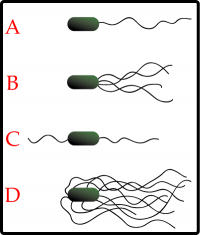The chapter fails to make clear that it is essentially promoting intelligent design creationism. While avoiding the phrase "intelligent design," the chapter relies heavily on the work of Michael Behe who is simply called "a biochemist from Lehigh University." The chapter neglects to mention that Behe is a leading intelligent design proponent and testified in favor of teaching ID in the public schools in the Kitzmiller v. Dover case. The chapter also avoids mentioning the significant point that Behe's arguments have been rejected by scientists and also were famously debunked during cross-examination and rejected by the court in the Kitzmiller v Dover trial  Bacteria with flagella The "intelligent design" movement presents the bacterial flagellum as a structure that supposedly could not have evolved, and therefore indicates the intervention of an "intelligent designer." Discovery Institute Fellow Michael Behe has been one of the most active promoters of erroneous claims about the bacterial flagellum.
Bacteria with flagella The "intelligent design" movement presents the bacterial flagellum as a structure that supposedly could not have evolved, and therefore indicates the intervention of an "intelligent designer." Discovery Institute Fellow Michael Behe has been one of the most active promoters of erroneous claims about the bacterial flagellum.
The bacterial flagellum is a complex molecular structure, typically made of about 30 different proteins. Ten more proteins are involved in building it.
The ID/creationist movement claims that the structure requires all of its protein parts to function, and therefore could not have evolved in a stepwise manner, and therefore an "Intelligent Designer" must have been required.
The bacterial flagellum in young earth creationist literature
Before the flagellum was adopted by the ID movment, it was already common in arguments of "creation scientists" (Battson 1986, Anonymous 1992, Anonymous 1994, Lumsden 1994). As Henry Morris, the founder of "scientific creationism," wrote in 2005:These well-meaning folks [ID advocates] did not really invent the idea of intelligent design, of course. Dembski often refers, for example, to the bacterial flagellum as a strong evidence for design (and indeed it is); but one of our ICR scientists (the late Dr. Dick Bliss) was using this example in his talks on creation a generation ago.see "The Design Revelation" by Henry M. Morris (2005)
A connection between EE and earlier creationist and ID literature are apparent in the graphical depictions of the bacterial flagellum. The graphics are identical to, or closely resemble, images from previous "ID" works. For example, Figure 8.1 on page 117 (and on pages 115 and 116) is the same graphic used for the cover of DI fellow William Dembski's 2002 ID book No Free Lunch, and in the Discovery Institute's "ID" video Unlocking the Mystery of Life.
